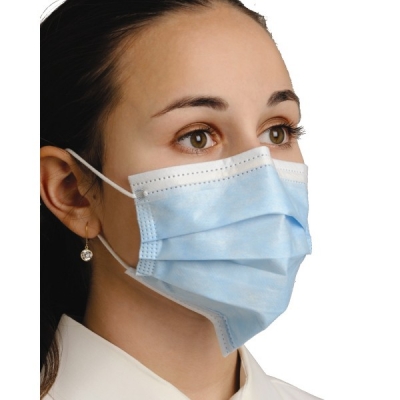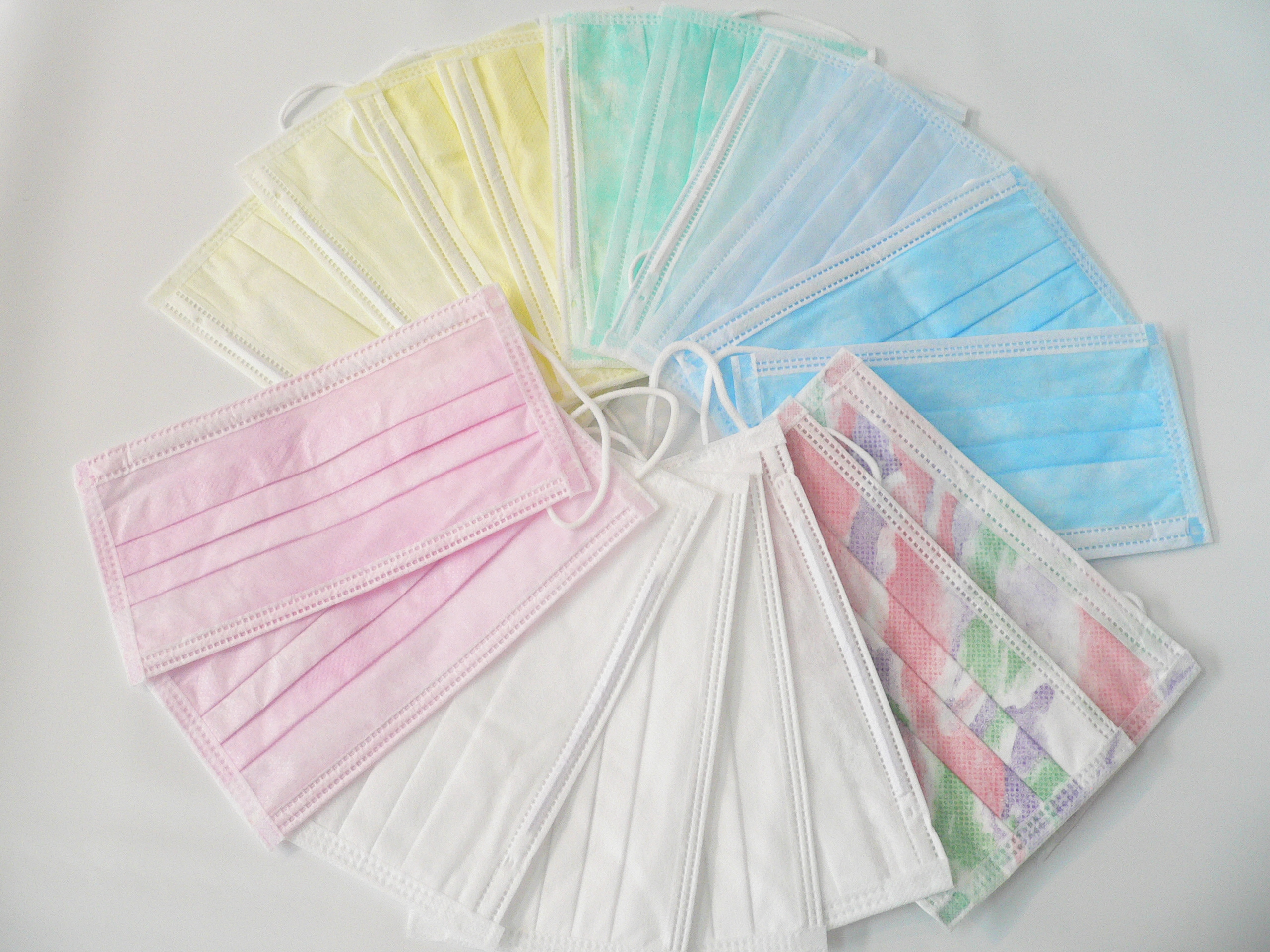Selecting the Proper ASTM Level Face Masks
There are a ton of different types of masks on the market. Face masks vary in level, color and patterns, fit, comfort, and price. However, are you buying and using the correct mask for the procedures you perform daily?
Because dental and healthcare professionals work in very close vicinity to aerosols, droplets and sprays, they're at risk to potential cross-contamination that could lead to infection. When it comes to Infection Control, personal protection equipment (P.P.E.) is an integral component in safety, and protective face masks are a front line defense to personal health and safety.
Disposable  Face Masks were initially recommended for protection against bacteria and viruses during treatments, but over the years, this has been expanded to include protection against spatter and aerosol particles during close range procedures.
Face Masks were initially recommended for protection against bacteria and viruses during treatments, but over the years, this has been expanded to include protection against spatter and aerosol particles during close range procedures.
With all the variations available, selecting the mask that will provide the proper level of protection for the task at hand can be confusing. Fortunately, that process has been made as easy as 1-2-3 with ASTM ratings!
What's ASTM?
The American Society for Testing and Materials (ASTM) have defined mask levels and when dental and healthcare professionals should be using which level mask throughout different procedures.
ASTM International is a global organization that develops and publishes technical standards for an expansive array of products, materials, systems and services. Today, more than 12,800 ASTM standards are in use around the world, including ASTM F2100-11, the standard for medical face masks since 2012.
Easy as 1-2-3
In developing ASTM F2100-11, the organization tested material used to make medical face masks on five performance metrics. Based on their test scores, ASTM assigns a numerical rating for the barrier performance of the material:
- LEVEL 1 - low risk of fluid exposure: For procedures where low amounts of fluid, spray, splatter and/or aerosols are produced in low concentrations. These are typically used in patient examinations, maintenance, orthodontics, taking impressions, laboratory work, operatory and general cleaning.
Performance Levels: Fluid Resistant 80 mmHg | BFE ≥95% | PFE ≥95% | Delta P ≤4.0 | Flame Spread Class 1
- LEVEL 2 - moderate risk of fluid exposure: For procedures where moderate to light amounts of fluids, splatter, spray and/or aerosols are produced in higher concentrations. These masks are ideal for restorative/composites, endodontics, prophylaxis, sealants, non-surgical periodontal therapy, scaling and root planning, limited oral surgery.
Performance Levels: Fluid Resistant 120 mmHg | BFE ≥98% | PFE ≥98% | Delta P ≤5.0 | Flame Spread Class 1
- LEVEL 3 - high risk of fluid exposure: For procedures where heavy to moderate amounts of fluid, spray, splatter and/or aerosols are produced in highest concentrations. These masks are ideal for crown preparation, implant placement, ultrasonic scaling, use of an air polisher, periodontal surgery, complex oral surgery.
Performance Levels: Fluid Resistant 160 mmHg | BFE ≥98% | PFE ≥98% | Delta P ≤5.0 | Flame Spread Class 1
How Masks are Tested
The Performance Metrics for Surgical Masks
- BFE (Bacterial Filtration Efficiency): The measure of efficiency of the mask filtering bacteria though it. Represents percentage of bacteria filtered out at pore size of 1.0-5.0 microns.
The Test: ASTM F2101 -This test measures the percentage of bacteria larger than 3 microns filtered out by the mask. The challenge material used is Staphylococcus aureus.
- Flud Resistance: Represents mask's resistance to penetration by synthetic blood under pressure (mmHg). Measures ability of mask's construction to minimize fluids from traveling through the material and potentially coming into contact with the wearer. The higher the fluid resistance (filtration), the better the protection.
The Test: ASTM F1862 - This test evaluates the resistance of a medical face mask to penetration by a small volume (~2 mL) of synthetic blood at a high velocity (80 mmHg, 120 mmHg, or 160 mmHg). The mask either passes or fails based on visual evidence of synthetic blood penetration.
- PFE (Particulate Filtration Efficiency): The measure of the efficiency of the mask in filtering particles passing through it. Represents percentage of particles filtered out at a pore size of 0.1 - 1.0 microns. The size of the particles filtered is critical.
The Test: ASTM F2299 - This test measures the percentage of particles larger than 1 micron filtered out by the mask. The challenge material used consists of latex aerosol concentrations in a controlled airflow chamber.
- Flammability
The Test: 16 CFR Part 1610: Flame Spread - This test exposes the face mask material to a flame and measures the time required for the flame to proceed up the material a distance of 127 mm (5 inches). Class 1 means the material exhibits normal flammability and is acceptable for use in clothing.
- Breathability Delta P (Differential Pressure): Determines breathing resistance. Represents the pressure drop across the mask or resistance to air flow in mmH20/CM2. Higher the Delta P, the less breathability, but the better the filtration.
The Test: MIL-M-36954 C: ΔP - This test determines the face mask’s resistance to airflow. A controlled flow of air is driven through the mask, and the pressure before and after is measured. The difference in pressure is divided by the surface (in cm2) of the sample. A lower breathing resistance indicates a better comfort level for the user.
Complete Protection
An ASTM mask protects your nose and mouth against splashes and sprays of blood and other bodily fluids, as well as bacteria and particulate matter of the sizes indicated in the above table; however, face masks do not provide respiratory protection against airborne diseases. For that purpose, a respirator is required.
What is a Respirator?
A respirator is a personal protective device that is worn on your face, covers at least your nose and mouth, requires fit-testing, and is used to reduce your risk of inhaling hazardous airborne particles (including dust particles and infectious agents), gases or vapors. A commonly used respirators is a NIOSH-approved N95 Respirator mask, which has been tested to filter out at least 95% of airborne particles. A Surgical N95 Respirator is a NIOSH-approved N95 Respirator that has been cleared by the FDA for use as a surgical mask. Unlike other masks, N95 respirators must be fit-tested for each individual to ensure proper protection.
Stay Protected
It is important to note that face masks be changed with each patient, changed every hour during long procedures and be changed every 20 minutes in highly aerosolized environments. Lastly, the way the mask is worn is also extremely important to personal repsiratory safety. There is a front and back to a mask-wear with the color facing outward. To be fully protected, the mask should be pulled over the nose, mouth, and chin and secured in place. With all of the key facts and safety factors in mind for facial protection, you can select an ASTM-rated mask that is right for you and protects the best. All you need to do is tap the link and ...
+shop for Face Masks here now
rders. Questions. Volume Discounts. Special Requests.
Click or Call Today
Monday - Friday 8:30am - 4:30pm EST
+800.274.4637 | +716.668.4001 | Fax +716.668.4496 | [email protected] | MDSassociates.com
"We want you to return home safely every day"
For more information about the Respirators and surgical masks, see OSHA Video: The Difference Between Respirators and Surgical Masks.




